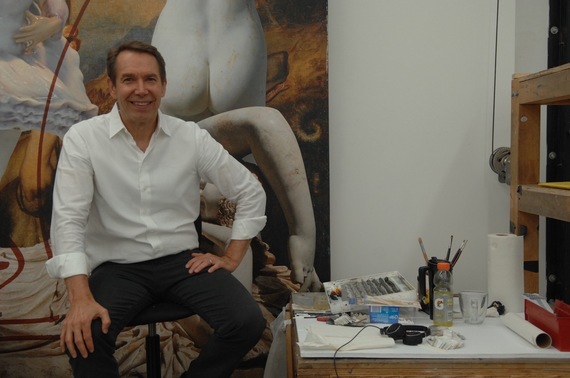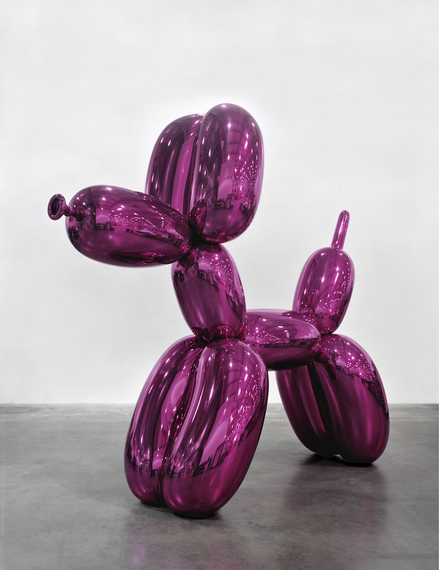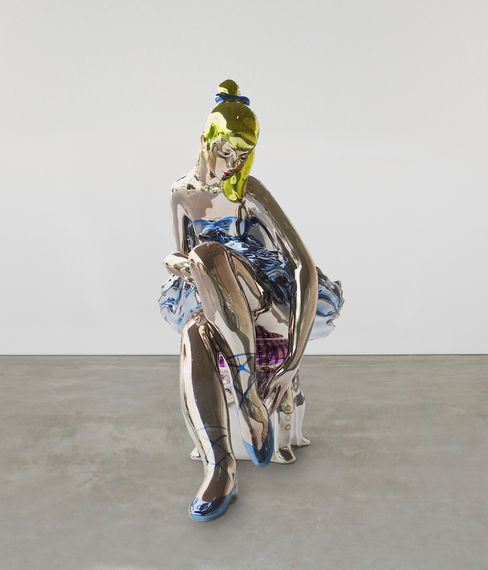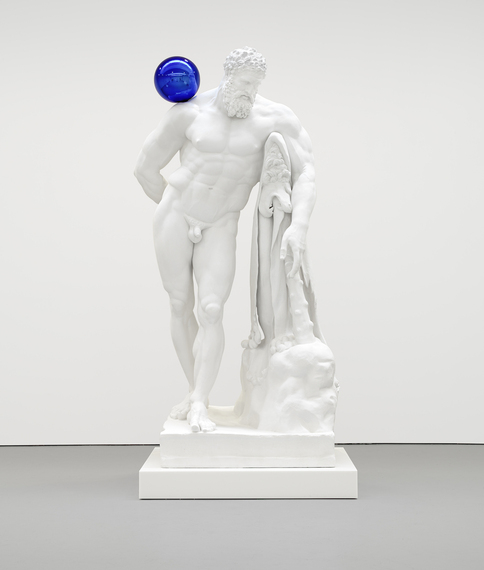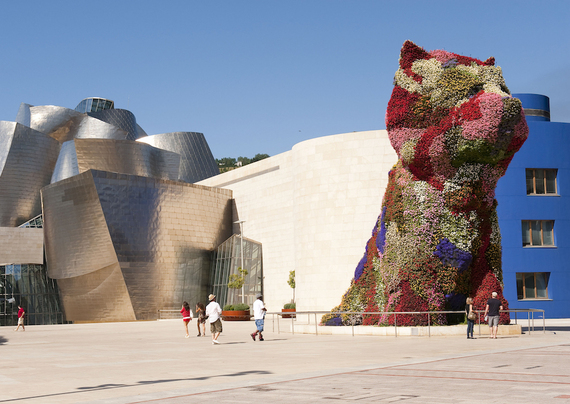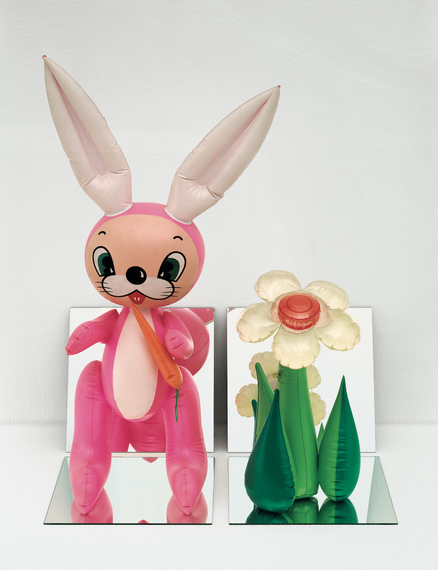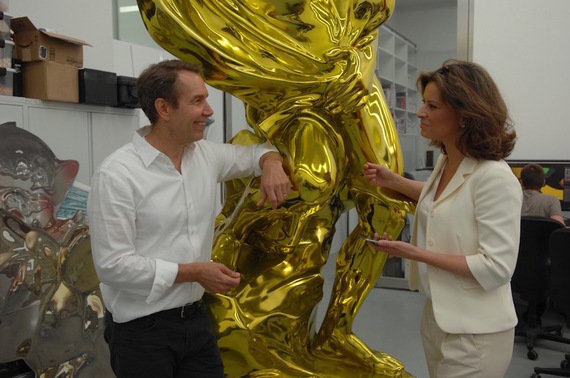Jeff Koons. Photo: Elena Cué
American artist Jeff Koons (York, Pennsylvania, 1955) can be considered one of the most influential artists of his generation. As a representative of the Post-Pop artistic trend, his work also feeds off movements such as Surrealism and Dadaism, as well as classical and Baroque elements as part of an interconnection of time with art history as a whole. He burst into the public arena back in the 1980s in New York, with his own interpretation of Duchamp's ready-mades in the style of Andy Warhol. He then evolved towards an art which blends the objective and more cerebral with the subjective and more sentimental. The work of Koons, full of sensuality and seduction, accurately depicts our post-modern capitalist era, which has made him successfully appealing to the masses. Koons tells us that we cannot comprehend his art if we do not previously let ourselves feel what his work awakens in us: the means to achieve, within the plane of ideas, the rational sense of his art. An optimistic message about overcoming and transcending that which is beyond the sensitive, inviting the spectator to converse with, and hence complete, his work.
I step into Jeff Koons' study in Chelsea and am greeted with his brilliant smile, his pleasant tone of voice and a matt white space in stark contrast with his satin sculptures.
You grew up in the United States while it was undergoing a cultural transformation at a time when the dream of the American way of life was conceived. How is that reflected in your work?
I was born in 1955 and I was brought up in a middle class family, but a family where we always felt a sense of mobility and a sense of opportunity. I think a lot of it had to do with the history of my grandparents, my parents, my aunts and uncles. A lot of them were merchants. My grandfather was the city treasurer in New York. My father had an interior design business and he had a decorating business, so we were always interacting with people and there was a sense of joy and fulfillment at being involved with a larger community. We felt that we could transform our lives. Our lives continued to get more interesting and there was always a sense that through hard work, you were able to better your life... through education and through experience. Through having strong experiences, you'd be able to continue to, in a way, achieve a transcendence.
You became well known in the 1980s, and while your generation was turning mainly to painting as a reaction to earlier conceptual art and minimalism, you instead turned to recycling objects: the readymade vacuum cleaners and balls suspended in water. In comparison to that eruption of expressionist sentiment, your work is like a blast of cold air. Were you trying to distinguish yourself from your generation?
I always enjoyed Dada and Surrealism. I went to the Maryland Institute College of Art in Baltimore, and then I transferred to the School of the Art Institute in Chicago. Chicago was very based in personal iconography. So the work made you have sensations, it made you have feelings. Feelings are at the basis of all ideas. First you have feelings, and then through those sensations it develops into ideas. And so I learned a personal iconography, I learned how to affect the way I felt. Then I learned how to affect the way other people felt, and I moved to New York. But I wanted to be involved with more objective art, and not deal so much with my internal life coming out of this tradition of Dada and Surrealism. And so I was drawn to the external world, and I believe that I learned how to trust in myself. Once you trust in yourself, you automatically want to go outside of yourself. I think I ended up working with objects as metaphor for people. And it's not about finding relevance or perfection or imperfection in objects, but it's that you can accept yourself, and then go out and accept others. That's really the highest objective state. And everything is metaphor for that state. Walking out of Plato's cave is this process of self-acceptance, to be able to accept other people. Through that, you are able to remove anxiety and hopefully reach the highest conscious state.
Balloon Dog (Magenta), 1994-2000 mirror-polished stainless steel with transparent color coating 121 x 143 x 45 inches 307.3 x 363.2 x 114.3 cm © Jeff Koons
Does your art express a nostalgia of childhood, as a kind of paradise without limits or repression?
I think back fondly to my childhood. I had the country farm that was my grandfather's. I have really fond memories of being there. I have fond memories of being an artist and coming into the consciousness and enjoying art around four or five years of age. All this time was kind of an exciting period, full of acceptance... being open to the world and enjoying everything. Not shutting down, not rejecting things. There is an openness and an accepting of everything being perfect in its own being and I love that openness. You don't really understand the mechanisms, but there is a certain point when you start to become more deeply involved, when you start to become aware that there are actually disempowering forces at work. There are actually people who want to create rules and certain frameworks to it that are actually empowering them and disempowering others.My art it's a way to get to people, to start to have a dialogue about culture and an embrace of culture, to try and pull them through or around that obstacle.
Do you think that highly developed societies are more repressed?
One of the things we look to the ancient societies for - we look to ancient Greece, we look to ancient Rome - is actually the openness and not having a repression taking place. We have the eternal in two forms; we have the eternal through life, leapfrogging through biology. So we have the biological realm of the eternal to keep life going forward, and then we have the realm of ideas - of abstraction and Platonism - just ideas, the eternal quality of ideas. And so in great works of art, you have both of these forms of dialogue taking place because they are both wonderful and have their place to enjoy the senses, to be able to reach the highest level of transcendence through the use of the senses. Senses become ideas. Leonardo da Vinci would say that the highest form of art is erotic art, because it affects all of the desires for transcendence, for preservation of the self, for procreation, for being and participating in a sense of oneness... and also the essence of the universe, all at once. When you look at the canon of art history, you look at all the great masters in art history, and they all embraced sensuality. They all embraced the joy of being alive through both body and mind.
What does your idea of freedom encompass?
To reach one's potential of consciousness. Over the last ten years, Picasso has really been an amazing figure for me. I always enjoyed Picasso's work, but I never felt freedom in his work. I would find freedom in Duchamp and the ideas of what I thought was objective art and then, at a certain point, I started to really look at Picasso and I started to live with Picasso's work and I realized that the objective and the subjective goes full circle. And Picasso's work is layer upon layer upon layer of intuitive thought. It just goes completely full circle into the realm of the universal vocabulary and into archetype, but it is completely objective. For me, Duchamp - well not Duchamp himself, but the type of thought that's been laid on top - became so distant. I felt a complete loss of freedom. And I realized this decades ago, but objects aren't what we're interested in; we're interested in people and that it's all metaphor. So Picasso was dealing much more on a personal level and dealing with the layering. I found a lot of freedom there. So it's the act of becoming better and better. And great artists get better. When I just mentioned that canon of art history, nobody got worse.
As an artist, how have you exerted more and more freedom?
I mentioned Plato's cave, and I want to reach the highest level of consciousness. I really believe that everything is paralleling us in life right now, and if we could only open ourselves up to the freedom that we have of gesture, we could see that what we really want to do is so accessible to us... it's mind-blowing, the vastness of gesture that we have. But we're kind of here with the blinders on, and I think that anxiety is one of the things that keeps people from doing that. So I would really like to reach a higher state of consciousness to be able to exercise that freedom. I mean I always envision that on your deathbed, all of a sudden, right when you come to your last breath, you may have a consciousness. And I don't want to experience that at death, I want to experience it now.
Seated Ballerina, 2010-2015 mirror-polished stainless steel with transparent color coating 83 x 44 3/4 x 77 7/8 inches 210.8 x 113.5 x 197.7 cm © Jeff Koons / Photo: Courtesy Consultatio Real Estate
By displaying the most basic instinct - sex - alongside the most elevated emotion - love - do you turn it into the banal or the sublime?
In my Banality series in 1988 that what I was trying to communicate to people is that they are perfect. That everything about their cultural history, everything about their own personal history is perfect. So when I did my Made in Heaven, it had to do with that same dialogue... but it was dealing with self-acceptance in the body. A lot of times, people reject themselves because they can't deal with their own body, they can't deal with their sexuality, they can't deal with themselves. So how to communicate that? I ended up getting involved in extending that dialogue there with the body. I saw Masaccio's expulsion and that type of guilt and shame on Adam and Eve's face, so that's what I was trying to communicate there.
And do you stand by that message to this day?
What I continue to communicate to this day, or what I try to share, is that throughout history, culture is paralleling our biological body. If you look at our genes it's all inter-connectivity. But outside our body, our cultural life is doing the exact same thing. We do this and we make these connections. I love Manet's work, and Manet loved Goya, and Goya loved Velázquez, and Velázquez loved the sculpture of Ariadne that he brought back by Praxiteles. This type of interconnectivity is paralleling our biological and it changes who we are. Ideas morph our genes. Now, it hasn't been proven by science to show that you can pass that on, but I don't need science to prove that. I myself personally know that I am a different human being from seeing Manet. It's about giving it up to things, it's about finding things outside the self that have relevance and that's connectivity... that's consciousness. And that's one of the key things about my work. Working with objects, these externalized things, are all metaphor for keeping it up. We don't care about objects. We're inanimate. But they help create this dialogue.
Gazing Ball (Farnese Hercules), 2013 plaster and glass 128 1/2 x 67 x 48 5/8 inches 326.4 x 170 x 123.5 cm © Jeff Koons/ Photo: Tom Powel Imaging
This message between past and present reminds me of the effect that your Gazing Balls exhibition in New York had on me, where a blue ball was balanced on huge classical Greco-Roman plaster sculptures. Why is there tension between the beauty of classical art and a mundane object?
I like gazing balls, and for me they are a symbol of generosity. Growing up and to this day, many people would put them in their garden or put them in their front yard. And it's really an act of generosity for their neighbor... that they will go by and look and have this visual intensity. They were originally created in Venice back in the 1500s, then they fell out of fashion and were repopularized by King Ludwig II of Bavaria. So he repopularized them and in Pennsylvania we have a lot of people of German ancestry, so that's maybe one of the reasons. Then you would go into these larger and larger dialogues about transcendence and then you would have a Farnese Hercules. So I was really having a Nietzschen and Platoism type of dialogue about the two kinds of parallel realms of the eternal. It was about affirmation.
Puppy, 1992 stainless steel, soil, geotextile fabric, internal irrigation system, and live flowering plants 486 x 486 x 256 inches 1234.4 x 1234.4 x 650.2 cm © Jeff Koons /Photo: © FMGB, Guggenheim Museum Bilbao, Bilbao, 2015 Photo: Erika Ede
You have said that one of your best exhibitions was the one at the Guggenheim in Bilbao, where Puppy is its emblematic sculpture. What made this exhibition a step above the rest?
I think that all the exhibitions were absolutely fantastic, but what I enjoyed very much about Bilbao was that there was a complete generosity to the architecture. I think another aspect that made the retrospective in Bilbao so special and so unique from the other ones, was that the public were able to come into the exhibition after passing Puppy. And Puppy had already started a philosophical dialogue about the work. It already gave it a spiritual realm because it's organic; it's these live growing plants... life and death. You have the mortality of the plants, the life cycle versus architecture, because of the organic and inorganic all being mixed together. So philosophically, that already takes the viewer in with a certain state of mind. Each plant is an element of control, a decision, but at the same time, it's about giving up control and walking away and then it's in nature's hands. Certain plants are going to want to move and dominate in one direction, others in a different direction. That's the beauty of it.
It's a good metaphor for life...
Yes, there are certain areas in life where you need control. You have to. If you don't, you're not able to make your life as productive as possible. But then there are other areas in life, such as relationships with people, where you have to give up control... there's no place for it.
What work would you say most represents who you are?
There truly isn't one. It's a compilation of all these different experiences. The first time I ever worked with an inflatable rabbit, I put it on two mirrors with an inflatable flower, with another two mirrors on the floor. And it was so intense for me, the visual experience. Hegel would say that the only way something inorganic can procreate is through reflection and I was looking at this. I mean I totally got it, because it was so charged and I had to leave. I had to go and have a beer, because it was just such a strong visual intoxicating experience. It was hard to come down from that intensity of the power of art and of the realization that certain colors and different textures and different kinds of metaphors could be communicated so perfectly.
Inflatable Flower and Bunny (Tall White, Pink Bunny), 1979 vinyl, mirrors 32 x 25 x 19 inches 81.3 x 63.5 x 48.3 cm © Jeff Koons
As a collector, you prefer Classical art. What are your criteria when it comes to buying art?
When I was younger, I would make trades sometimes with artists and I've acquired some contemporary art. When you're collecting art, you're able to really absorb and time-travel and feel what it was like to feel the sensations of that person. So I like that type of perception of the metaphysical quality. And art is something that occurs within the viewer, within the individual. A great Giorgione painting is what you feel. The art is a perception of your own possibilities, your own sense of what you can accomplish, how you can expand your parameters in life. That's what is of value. The only thing with value is how your life can be better. I feel in contact with that through dealing with things that aren't contemporary, because there is a timeless quality and I'm curious about archetypes and things that are dealing in the universal.
You don't seem to suffer the solitude of the artist; yours seems more like a "communal" art.
My work is generated from myself and it comes from a process of following my intuition and through letting things resonate over a period of time. I've had people around me who - because of making paintings or sculptures - I've been able to use to help me realize some of these different works. But at the end of the day, I'm responsible for everything. So the creative process is not communal. I'm in front of it, because it's the gesture. For me, it's that freedom of gesture. So the blank canvas is in front of me at every moment. Every day that I wake up, it's right there. To make the things that I really want to make and to do the things that I really want to do in life, I have to do it. I really think it's totally the same as a painter - whether somebody is thinking about that with a frame in front of them, or how they're exercising their medium of consciousness and medium and practice - but it's still about that gesture.
With your symbols of the banal, are you showing us our world, as if to say, this is what we are, this is how things are... deal with it?
I believe in communication. That's how I think about the viewer. It's not to get any response from them, other than what I put into it... the excitement, the energy. You know, I make something because I'm in awe and wonder of what that idea is and what that will be like. I'm excited by it. I just want them to feel that. The viewer always finishes it; they bring their own history, they bring other things to it, but I want them to feel a sense of potential and to feel vaster than prior to the experiencing of that work.
You went further than other American artists such as Tom Wesselmann or Mel Ramos, who transformed sex into Pop, by making your own exhibitionism into Pop art...
One of the things that I've always enjoyed about Pop art is that it is an art style that has quite a cerebral dialogue taking place. And it helps communicate that information. Not in such a dry, cerebral way, but it takes information and it helps continue to reinforce that ideas come through feelings, so that people can feel a little aroused, they can feel excited and communication can come to you through the genitalia or other parts of the body. Because if you present people with dry, cerebral ideas you can lose them. They don't understand how abundant everything is around them. So it's to communicate really the vastness of ideas. The last thing I would want to do is to have a dialogue about the readymade and a discourse of dry, cerebral quality, because that's not life. Life is everything and this is what the Pop artists did, like you mentioned. I really think that the strength of Warhol was that he was able to have a dialogue about life and death taking place, and he'd use the metaphor for the abstraction of what happens in the printing process of silkscreen - how clear something could be and how precise to a definitive, figurative representation - and representing life through something that's pulled more abstractly and doesn't completely come through more deathly. Again, this was a very central approach, of course, for Lichtenstein and all of the Pop artists.
Jeff Koons. Photo: Elena Cué
Spanish version: Entrevista a Jeff Koons

